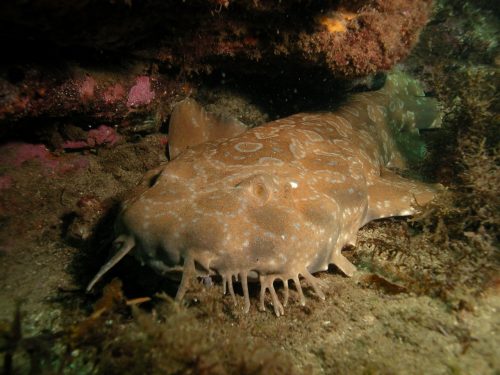
Orectolobus maculatus
This carpet shark has a flattened stocky body, stout tail, and wide lobed fins. Its upper lip is lined with dermal lobes that act as both camouflage and as bait for unsuspecting prey. This wobbegong can be distinduished from other wobbegong species by its golden sandy to light green color with a dark saddle across its body and a white irregular ring pattern.
Order: Orectolobiformes
Family: Orectolobidae
Genus: Orectolobus
Species: maculatus
Common Names
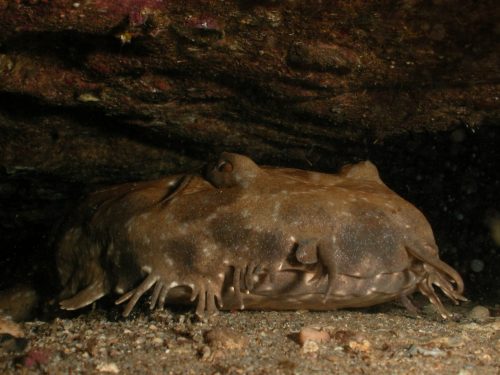
O. maculatus is commonly known as the wobbegon or spotted wobbegon in the English language. Other common names include:
gevlekte bakerhaai (Dutch)
rengaspartahai (Finnish)
requin-tapis tacheté (French)
wobbegong (German)
kumohada-ôse (Japanese)
tapicero manchado (Spanish)
Importance to Humans
Spotted wobbegong flesh is often considered excellent for eating. Furthermore, the skin of the shark is very tough and makes beautifully patterned leather (Last and Stevens 2009). Nevertheless, the shark is of limited commercial value. It is a pest to many lobster fishermen as it is known to trap itself in their lobster pots.
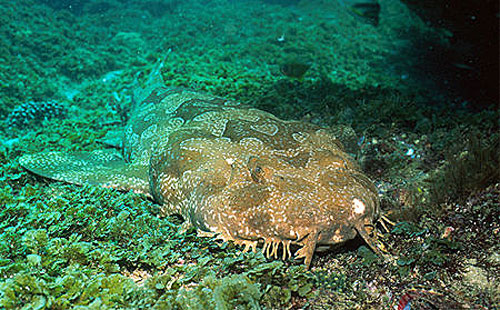
Danger to Humans
The spotted wobbegong can be aggressive. There are multiple accounts of unprovoked attacks on divers well above the bottom (Michael 2005). There are also reports of wobbegongs biting people if stepped on, or when limbs come close to the mouth and are mistaken for prey. This shark is often reluctant to let go once it bites, causing severe lacerations. According to The International Shark Attack File, there have been 4 confirmed unprovoked attacks on humans by spotted wobbegongs in addition to the 28 bites from wobbegongs whose species was not determined.
View shark attacks by species on a world mapConservation
IUCN Red List Status: Least Concern
Wobbegongs are often caught as by catch in trawls, and lobster pots (while getting stuck foraging for food), as well as spearfishing. In New South Wales wobbegongs were targeted in the early 90’s by trawl fisheries. After numbers declined locally it was listed as “vulnerable”. As fishing intensity decreased the population stabilized (Pease and Grinberg, 1995; NSW Department of Primary Industries, unpubl. Data). In the mid 2000’s New South Wales saw a drop in harvest numbers again. After a biological review, new bag and size limits were implemented.
> Check the status of the spotted wobbegong shark at the IUCN website.
Geographical Distribution
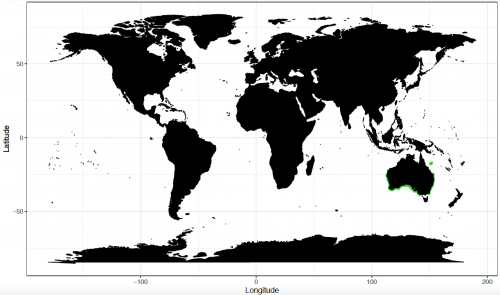
Spotted wobbegong are native to the western Pacific Ocean around Australia (Kyne et al. 2005). Previous records of the species in Japanese and the South China Sea were likely misidentifications (Last and Stevens 1994, Compagno 2001).
Habitat
Occurring on continental shelves, from the intertidal zone down to 218 m (715 ft.) depth (Kyne et al. 2005), O. maculatus is commonly found on or around reefs, under piers, and on sandy bottoms. There have been many sightings of this shark in water barely deep enough to cover its entire body. It is considered sluggish and inactive and is often found resting on the ocean floor (Michael, 2005).
Biology
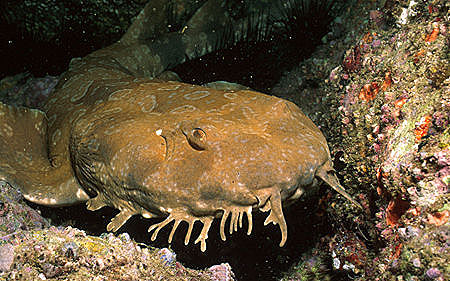
Distinctive Features
There are 8 to 10 dermal lobes around the mouth and on the sides of the head in combination with nasal barbels. The first spineless dorsal fin starts over the pelvic base, and the anal fin initiates behind the second dorsal fin origin. The caudal fin is shorter, and the pectoral and pelvic fins are broad. O. maculatusis are also characterized by the presence of large spiracles, nasoral and circumnarial grooves, with an absence of caudal keels or ridges on the body. While other species of wobbegong are similar in appearance, the pattern O. maculatus is distinctive.
Coloration
Pale yellow or greenish brown with large dark saddles down center of back and many small, white O-shaped markings over its entire dorsal. This pattern in combination with your dermal lobes make for excellent camouflage.
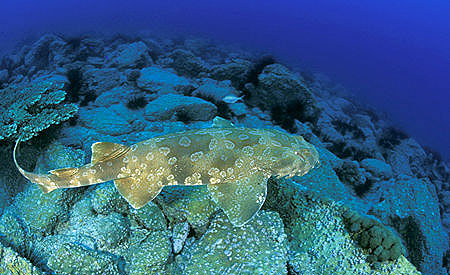
Dentition
The teeth of the spotted wobbegong are described as enlarged fangs; they are long, slender, and sharp. There are two lateral rows in the upper jaw and three lateral rows in the lower jaw.
Size, Age, and Growth
The Spotted Wobbegong was previously reported to reach maturity at 60 cm (2 ft.) (Compagno 2001), however this is likely a case of mistaken identity with the Dwarf Spotted Wobbegong from Western Australia (Last and Chidlow 2008). Spotted Wobbegong are now known to mature at 120 cm (4 ft.) (Huveneers et al. 2007b). Maximum length is about 320 cm (10 ft.), but most individuals only grow to 150-180 cm (5-6 ft.) (Compagno 2001).
Food Habits
Diet includes; invertebrates such as crabs, lobsters, octopi, as well as bony fish and even other small sharks (Michael, 2005). This shark is a nocturnal hunter, and rests during the day. O. maculatus can extend their mouth by as much as 30% of the nasal distance from its anterior most point to the anterior edge of the pectoral fin, to capture prey. This is equivalent to the combined length of the head and branchial arches. They often wait for prey to wander near its mouth before striking. Prey have even been known to nibble on this shark’s dermal lobes before being eaten. Individuals have been observed to slowly sneak up on its prey over long distance.
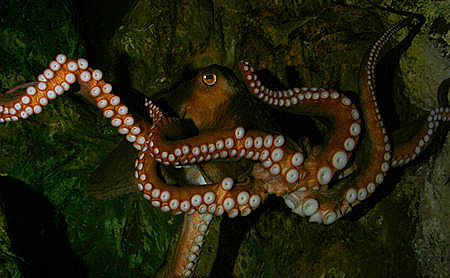
Reproduction
The species is ovoviviparous, giving birth to as many as 37, 23 cm (9 in.) pups (Grant 1978; Huveneers et al. 2007). During breeding season, the male is attracted to the female by chemical pheromones that she releases into the water. The male attaches to the female by biting near the gills and then copulates (Michael, 2005). Females have a triennial reproductive cycle, follicles take two years to mature before ovulation. Gestation lasts 10-11 months, with pups being born September-October (Huveneers et al. 2007b). New pups are born at 23 cm (9 in.) (Huveneers et al. 2007b).
Predators
Any large fish or marine mammals are potential predators of the spotted wobbegong.
Parasites
The onchobothriid tetraphyllidean cestode is one known parasite of the spotted wobbegong. Thirty-three species of this cestode are parasitic to the spiral intestine of this shark; they are of the genus Acanthobothrium. The nematode Echinocephalus overstreeti is also a known parasite of this shark.
Taxonomy
This shark was named Orectolobus maculatus by Bonnaterre, 1778. Orectolobus is derived from the Greek word orektos, which means, “stretch out,” and the Greek word lobos, which means, “lobe.” The genus name maculatusis derived from the Latin word maculosus, which means, “spotted.” This shark has also been referred to asSqualus maculatus Bonnaterre 1778, Squalus barbatus Gmelin 1789, Squalus lobatus Bloch and Schneider 1801,Squalus appendiculatus Shaw & Nodder 1806, and Squalus labiatus Bleeker 1857.
References
Compagno, L.J.V. 2001. Sharks of the world. An annotated and illustrated catalogue of shark species known to date. Volume 2. Bullhead, Mackerel and Carpet Sharks (Heterodontiformes, Lamniformes and Orectolobiformes). FAO, Rome.
Grant, E.M. 1978. Guide to fishes. Department of Harbours and Marine, Brisbane
Huveneers, C., Walker, T.I., Otway, N.M. and Harcourt, R.G. 2007. Reproductive synchrony of three sympatric species of wobbegong shark (genus Orectolobus) in New South Wales, Australia. Marine and Freshwater Research 58(8): 765–777.
Kyne P.M., Johnson J.W., Courtney A.J. and Bennett, M.B. 2005. New Biogeographical information on Queensland Chondrichthyans. Memoirs of the Queensland Museum 50: 321-327.
Last, P.R. and Chidlow, J. 2008. Two new wobbegong sharks, Orectolobus floridus sp. nov. and O. parvimaculatus sp. nov. (Orectolobiformes: Orectolobidae), from southwestern Australia. Zootaxa 1673: 49-67.
Last, P.R. and Stevens, J.D. 2009. Sharks and Rays of Australia. Second Edition. CSIRO Publishing, Collingwood, Australia.
Michael, S.W., 2005. Reef sharks and rays of the world. ProStar Publications.
NSW Department of Primary Industries. 2006. Fisheries Management Strategy for the NSW Ocean Trap and Line Fishery. NSW Department of Primary Industries.
Pease, B.C. and Grinberg, A. 1995. New South Wales Commercial Fisheries Statistics 1940 to 1992. NSW Fisheries, Cronulla, Australia.
Revised by Tyler Bowling and Gavin Naylor 2018
Original preparation by Dane Eagle